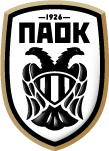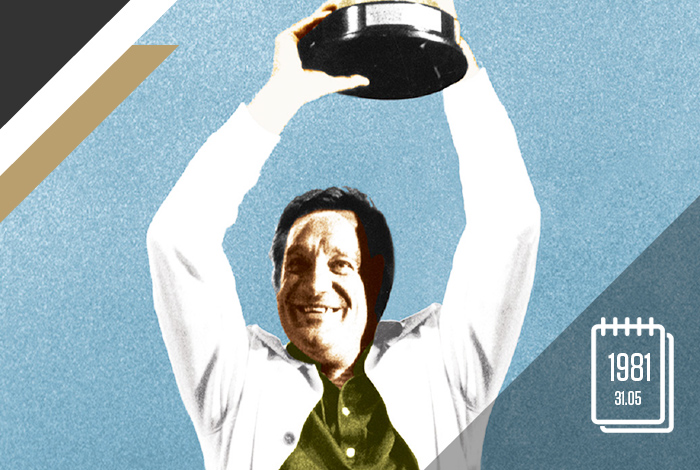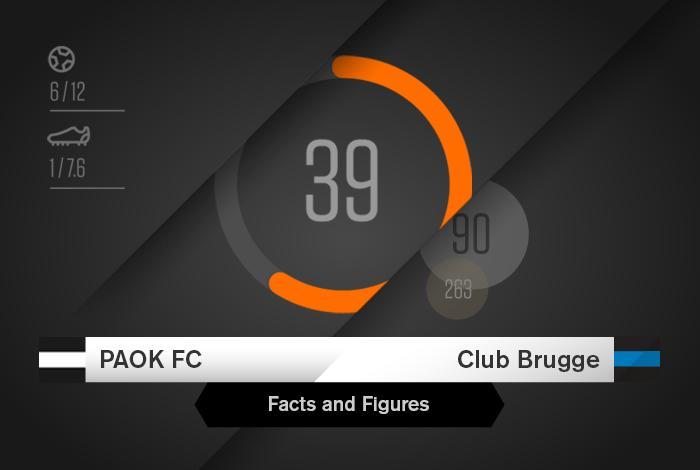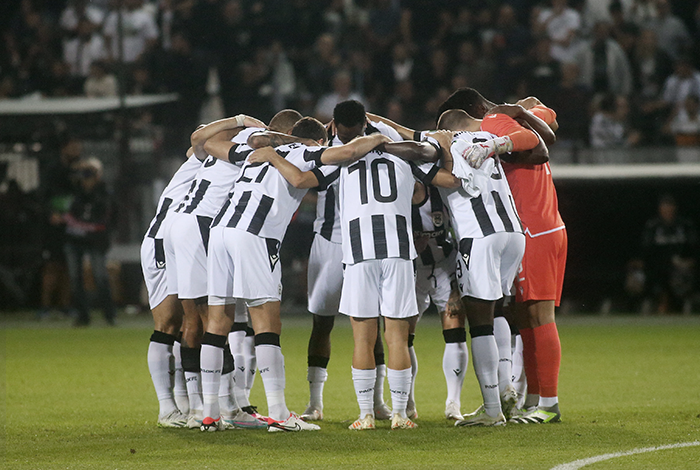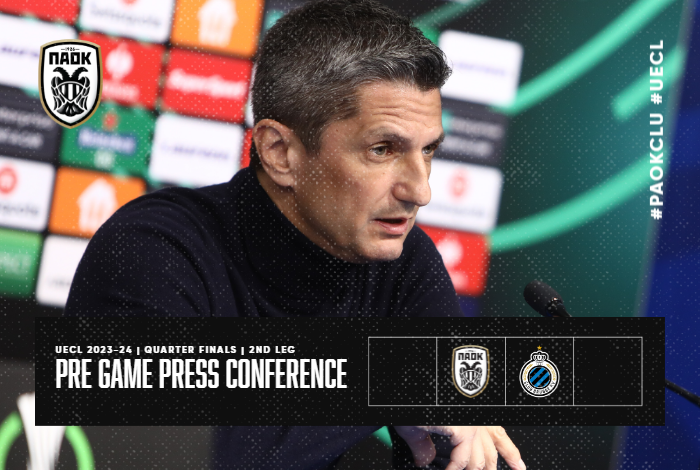The day we lost Lóránt
Seven years after his debut for PAOK was a derby win against Olympiacos in December 1974 (2-0), Gyula Lóránt’s final match in his second spell with Dikefalos tou Vorra produced another win – again in a derby match against Olympiacos. The only difference this time was that, sadly, he did not live to see the players celebrate it …
PAOK seemed to be the ideal solution for him. It offered him the sunshine he needed to help him overcome his skin problems and, most importantly, the opportunity to win titles. And so, at the end of 1974, Gyula Lóránt moved to Thessaloniki, the city where he became a myth and the place where he was to where it was to breathe his last breath. On this day, May 31, in 1981. While in the dugout. Like a great captain who did not abandon ship, even when he felt his strength wavering.
Just like his debut for PAOK which was a derby victory over against Olympiacos in December 1974 (2-0), so to was his last game, a chapter written seven years later. In his second spell at the club, he again guided the team to a win over Olympiacos. Only this time he did not get to see the players with the Double-headed Eagle on their chests celebrating …
In the 17th minute of the PAOK vs. Olympiacos at the Toumba on Matchday 32 of the championship, Lorant shouted something to his associates on the bench. Nobody understood what he said and immediately afterwards they realized he collapsed on the ground. The PAOK doctor tried to revive him without success, and after initially being transferred to the Toumba dressing rooms, eight minutes later he was transferred via ambulance to the Hospital of Thessaloniki, where he was confirmed dead.
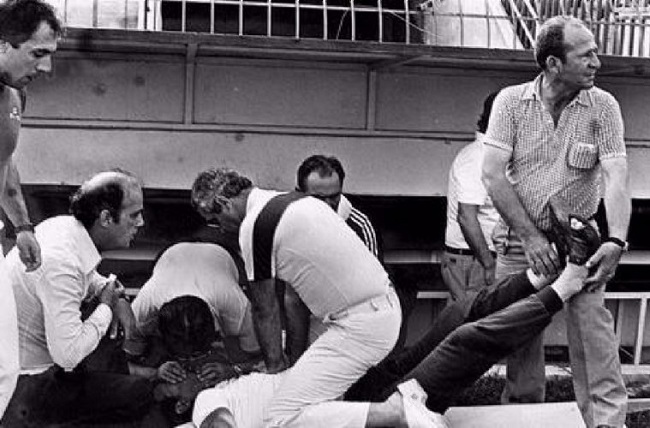
Meanwhile on the pitch, the match continued. The players looked over at the dugout and had an idea that something was happening when their coach was missing. At half-time, club officials and coaching staff decided not to tell the players the full truth. They were simply told that Lorant had felt unwell and was taken to hospital.
On that sweltering afternoon at the Toumba, the great Magyar did not manage to finish the game against Olympiacos. The doctors had said that «his heart was pounding, he must have had heart disease for the last five years.» His players, without knowing the tragic end, were called to continue the second half as normal. They won 1-0 with a goal from Vasilakos. After the final whistle, the truth was revealed and they remained their for a long time, soul searching and speechless.
Another parallel tragedy played out at the Toumba stadium. Lorant’s wife, Ive, and their young daughter, Molki, heard on the radio that Lorant had collapsed and went straight to the stadium to find out what was going on. Lorant’s interpreter took them to the hospital and informed them of what had happened.
Prior to that fatal heart attack on May 31, 1981 at the Toumba, a forensic report had showed that Lorant had suffered two previous heart attacks. The first came six months earlier and the second just one week before the fatal one!
The shock caused to the PAOK family by Lorant’s loss was immense. A characteristic of that fateful day is that two more tragedies unfolded on the exact same day.
Later on that Sunday night, Christakis, the popular singer who was at his paternal home in Kavala, passed away while trying to recover from a stroke. Christakis (Christos Syrpos) was a friend of Lorant’s … He had met him in Thessaloniki during his first stint at the club and had visited him in Frankfurt when he was the coach of Eintracht, a club he had taken from bottom of the table to the upper reaches of the Bundesliga.
Christakis was recovering from a stroke that had left him with a disability on his left side. Lorant regularly hosted him at his home and offered him all the help he could. When the singer heard about the loss of his friend, he suffered a third and fatal stroke.
Also on the same day, a PAOK fan, 26-year-old Michalis Boretos, lost his life upon hearing the news of Lorant’s death, following a fall from an air shaft in his apartment building.
Who was Lorant
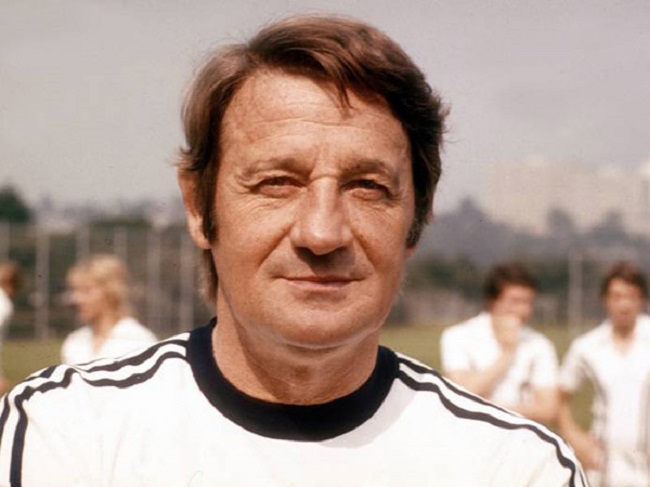
Gyula Lóránt was born in Hungary on February 6, 1923. A midfielder, he was a member of the legendary 1950s Hungarian national team which he later became coach. He also coached in Germany with Kaiserslautern, Duisburg, Cologne, Kickers Offenbach (assisted by Otto Rehhagel), Eintracht Frankfurt, Bayern Munich and Schalke, before his career and life came to an end at the Touma. He took charge of a total of 89 games for PAOK and is third on the all-time list behind Les Shannon and Angelos Anastasiadis.
In January 1949, Lorant attempted to emulate Laszlo Kubala, who crossed the border and made it into Italy via Austria, but Lorant was arrested at the border with Austria after found to be hiding in the back of a truck. He spent the next 10 months of his life in a concentration camp, imprisoned by the new communist government. He was finally released when Hungarian national team coach Gusztav Sebes intervened.
One of the reasons he chose to move to Greece and PAOK was the advice of his doctor. To deal with a skin condition that had plagued him for years, it was advised to him that he should live in a warmer country with plenty of sun and light.
Lóránt took over the technical leadership of PAOK in December 1974 and his debut as mentioned was a victory against Olympiakos (15/12/1974) by a 2-0 scoreline at the Toumba.
Under Lóránt, PAOK finished first in the 1975-76 season, celebrating its first-ever league title, which was actually won in the derby against AEK, a match which PAOK won 1-0 thanks to Guerino’s famous goal. «We played all year round with rubber boots,» said the Hungarian coach shortly afterwards, wishing to highlight the difficulties that PAOK had to face in order to achieve their great feat.
At that time, however, it seemed that PAOK was beginning to spread its wings competitively, as history wrote, among other things, that it was with Lorant at the helm that PAOK prevailed 1-0 over Barcelona at the Toumba, in one of the first matches to feature Johan Cruyff with teammate Johan Neskens for the Blaugrana.
In the summer of 1976, however, Lóránt chose to leave, as George Pantelakis could not meet his high financial demands, while the unsavory incidents at the Rizoupoli stadium a few months earlier also played an important role, with some club officials of the team who wanted to sit in the dugout sent to the stands by the Magyar coach. It was an episode that was obviously not forgotten, despite the firefighting interventions that took place.
He returned to PAOK at the end of April 1980 for his second spell at the club which was to end in such tragic circumstances.
